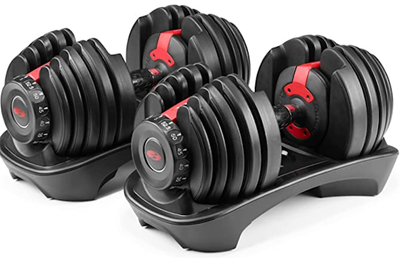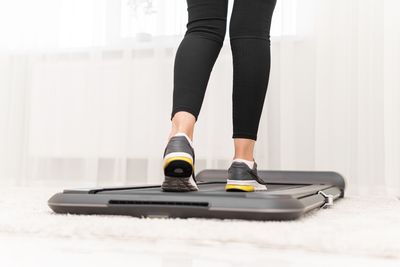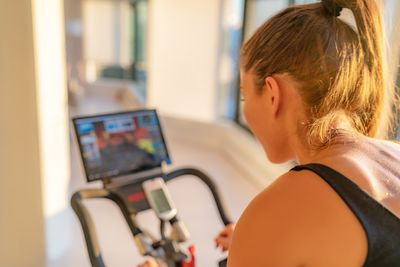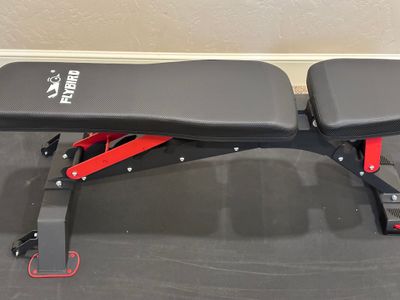
Not to worry! We’ve spent hours combing the internet, compiling research, and talking to experts to pinpoint some key considerations to help you choose a treadmill that aligns with your budget, space, and fitness goals.
Our Treadmill Experts
To help you choose the right treadmill for your fitness goals, we consulted the following experts for insights on this article:
- Michael Hamlin, NSCA, CSCS, Personal Trainer and Founder at Everflex Fitness
- Mike Ellingboe, Senior Store Manager of Johnson Fitness & Wellness (JFW) in Los Angeles
- Alexa Duckworth-Briggs is a UK Athletics certified Running Coach and a We Run Coach for clients in the UK and US
Consider Your Fitness Goals
Walking, running, jogging, weight loss, cardio fitness, muscle toning, or general health improvement…the possibilities are endless with a treadmill. That’s why it’s important to consider your fitness goals before you start shopping. If you're a casual walker, your needs will differ from a dedicated runner or someone training for a half marathon.
Expert Tip: “This is where we always start with product decisions. Your goals determine what type and brand of treadmill you will want to buy. If you're primarily going to run on the treadmill, look for a model with a powerful motor, stable frame, and ample running surface. If you're mainly walking or light jogging, a treadmill with a slightly less powerful motor and a smaller running surface might be suitable.” –Michael Hamlin, NSCA, CSCS, Personal Trainer and Founder at Everflex Fitness
Expert Tip: “If you're aiming for body composition changes, like weight loss or muscle gain, prioritize models like the Matrix T75 with proven workout programs designed for those purposes. Serious runners who train for races and marathons might opt for treadmills for intense training equipped with inclines for challenging runs, such as the NordicTrack Elite Treadmill. This treadmill entails limitless training options built with capabilities to run with elite personal trainers, live interactive training, and endless options for global workouts around the world. You can also use the stat tracking feature to keep track of your performance over time.” –Mike Ellingboe, Senior Store Manager of Johnson Fitness & Wellness (JFW) in Los Angeles.
Available Space and Treadmill Size
Treadmills come in a variety of sizes, making it essential to measure the space in which you plan on storing your equipment. Start by measuring the room's footprint, including the floor-to-ceiling height, especially if you're tall or plan on using the incline feature.
Make sure to allow plenty of space around the treadmill to get on and off safely. It’s recommended to leave at least two feet of clearance on either side of your treadmill and six feet behind it, according to the nonprofit organization, Consumer Reports.
Once you know the room size, you can compare those measurements to the treadmill dimensions. There are three treadmill dimensions worth noting when finding the ideal fit for your home: length, width, and height.
On average, the dimensions of home treadmills range from around 60 to 84 inches long and 25 to 36 inches wide. The height of a treadmill generally ranges from 50 to 70 inches and depends on its design and features, including the console and handrails.
Treadmills designed for running often have a longer deck to accommodate a full running stride but you'll want to ensure that the running surface or belt is large enough for your stride. A minimum of 50 inches in length and 20 inches in width is preferable.
That said, walkers can get by with a shorter belt since they have a shorter stride, so if you find a treadmill you like, and you’re a walker, don’t rule out machines with a belt under 50 inches long.
Expert Tip: “Runner’s, especially with longer legs, should opt for a spacious belt, ideally around 55 to 60 inches in length and 20 to 22 inches in width.” –Alexa Duckworth-Briggs is a UK Athletics certified Running Coach and a We Run Coach for clients in the UK and US
Expert Tip: “If space is a concern, consider a folding treadmill. These can be folded up for storage, but keep in mind that they may be less sturdy than non-folding models. I find many business professionals like these smaller folding ones as they sometimes want to exercise while working.” –Michael Hamlin, Personal Trainer and Founder at Everflex Fitness
Treadmill Types
One of the most important factors to consider when buying a treadmill is whether to go with a manual or motorized machine. Both have advantages and disadvantages, so it often comes down to preference, budget, and space.
Motorized Treadmills
Motorized treadmills are powered by a motor that sets the pace of the belt. You can adjust the speed and incline by the touch of a button, making it easy to use while running.
Because motorized treadmills provide a consistent belt speed, you’ll notice a smoother and more controlled pace while running or walking.
Many models come with premium features like pre-set programs, heart rate monitoring, connectivity to fitness apps, and connected HD touchscreens.
Manual Treadmills
Manual treadmills are powered by your own movement instead of an electrical motor. They are generally smaller in dimensions, more affordable, and do not require an electrical outlet.
>>> See our favorite small in-home treadmills
Since walking or running is required to keep the belt in motion, a manual treadmill may feel less smooth than its motorized counterpart.
Manual treadmills also come with minimal features compared to a motorized treadmill. For example, they lack preset programs and adjustable inclines. Some people opt for a manual treadmill if they have limited space or only plan on walking at slower speeds.
iFIT
Best Connected Treadmills
The iFIT app gives you access to one system you can use on iFIT-enabled equipment, Bluetooth-connected machines, and a compatible mobile device or TV.
Instructor-led studio classes
Instructor-led audio workouts
140+ workout series
Treadmill Weight Capacity
When choosing a treadmill, it's important to select one with a weight capacity that comfortably accommodates the heaviest user who will be using the treadmill. In general, treadmills range from a maximum user weight of 200 to over 400 pounds, with 300 pounds being the average.
Expert Tip: “The Matrix TF50 provides a comfortable and secure workout experience with an ultimate deck system, heavy-duty frame, and extra thick deck with industrial-grade cushions for miles of durable performance. Plus, this treadmill has a maximum user weight capacity of 400 pounds.” –Mike Ellingboe, Senior Store Manager of Johnson Fitness & Wellness (JFW)
Expert Tip: “Prioritize treadmills with superior cushioning to safeguard your joints, especially important for frequent runners.” –Alexa Duckworth-Briggs, UK Athletics certified Running Coach
Treadmill Motor Power and Performance
The motor is where it’s at when it comes to a treadmill’s power and performance. That’s because the motor is responsible for powering the treadmill's belt, and the higher the motor power, the faster the belt can move. For reference, the motor power is measured in horsepower (HP).
As far as the ideal amount of horsepower, that depends on your goals. Duckworth-Briggs says walkers can benefit from a treadmill with a motor between 1.5 to 2.5 HP, with 2.5 being ideal.
Runners, or anyone wanting to use the treadmill for high-intensity workouts, should consider a treadmill powered by a robust 2.5 to 4.0 HP motor for smooth operation.
Remember, if you see a reference to horsepower, you’re looking at a motorized treadmill. A manual treadmill is powered by human movement.
Treadmill Speed
Whether your workout plans include walking, running, or a combination of both, the belt speed plays a critical role in how you will use a treadmill.
The speed is typically measured in miles per hour (mph), with most treadmills having a speed range of 2 to 12 mph, but some treadmills can go up to 18 mph or more.
A comfortable walking speed is generally between 2 and 4 mph, whereas a fast or speed walking pace is about 4 to 5 mph, with the higher end including some jogging.
If you’re a runner, it’s common to start with 5 mph and increase your speed based on your current fitness level. A treadmill really gets moving when you reach speeds over 7 mph.
Expert Tip: “Ensure a maximum speed of at least 10 mph, with competitive runners aiming higher.” –Alexa Duckworth-Briggs, UK Athletics certified Running Coach
Incline and Decline Options
The incline determines the height of your running surface. A flat surface, which is the starting point for a treadmill, is considered 0% incline.
Most motorized treadmills with incline capabilities range from 0 to 15%. Like the speed, the incline you choose will also depend on your fitness level and goals.
If you’re a beginner, you may want to start with a lower incline and gradually increase it as you get stronger.
But if you’re an experienced runner or hiker accustomed to hilly terrain, you may want to choose a treadmill with a higher incline range.
While less common than the incline feature, some treadmills also come equipped with a decline setting, which simulates walking or running downhill. The decline levels typically range from -1% to -6%.
Expert Tip: A 10% to 15% incline range can help to emulate outdoor terrains.” –Alexa Duckworth-Briggs, UK Athletics certified Running Coach
Treadmill Console and User Interface
The performance of a treadmill is not just limited to the belt and motor. You also need to factor in the console and user interface, especially if you’re looking at higher-priced equipment.
The console is the control panel on your treadmill and it’s what you’ll use to adjust the speed, incline, and other settings. Treadmill consoles may also come equipped with built-in speakers, pre-set workout programs, advanced tracking, heart rate monitoring, distance covered, and calories burned.
A console should be easy to navigate through different settings, programs, and options. So, make sure you can see the information being displayed without having to stop the machine.
Beyond using the attached console, you’ll also want to consider built-in connectivity features like Bluetooth or Wi-Fi that allow you to connect the treadmill to your smartphone or tablet to track your workouts or listen to music.
Some treadmills have interactive consoles, such as connected touchscreens, that allow you to watch videos, stream live classes, and participate in on-demand workouts while you exercise.
Expert Tip: “Choose a treadmill that offers a range of workout options or programs, so you have variety while keeping your own workout style in mind. If you want a well-rounded workout experience from one machine outside of just cardio, I'd recommend the Matrix brand’s premium treadmills. Many of them are equipped with the iFit app, which allows users to explore thousands of interactive workouts, including strength, yoga, and more plus, live studio classes and global workouts using Google Maps. Additionally, Matrix treadmills are equipped with the Sprint 8 system, a high-intensity interval training program that burns fat and builds muscle in short workout periods that anyone can work into their schedule. Whether you're a beginner or an advanced athlete, having a range of workout options will help you stay motivated and achieve your fitness goals.” –Mike Ellingboe, Senior Store Manager of Johnson Fitness & Wellness (JFW)
Budget Considerations
Treadmills under $1,000 are often lightweight and built for walking. They tend to come with minimal features and work best for single use.
Machines in the $1,000 to $1,500 range come with more power, durability, and are typically able to handle light jogging workouts in addition to walking. You can also find treadmills in this budget category that can handle more than one user.
The sweet spot for a reasonably priced treadmill that also comes with solid features, good mechanics, cushioning, and the ability to handle walking and running is about $1,500 to $2,000.
Once you hit the $2,000 to $3,000 range, the possibilities are endless, and you should have no problem finding a treadmill that checks all the boxes.
Equipment at this price generally comes with touchscreens, subscription content, multiple incline and decline levels, a wide range of speed options, and the durability to support multiple users.
If you have the cash, and want to go all in, there are some luxury home treadmills priced over $3,000. These premium machines feature maximum cushioning, multiple speed settings, extended incline and decline ability, large running surfaces, top-of-the line connected touchscreens, high-quality sound output, and more.
Expert Tip: “Quality and cost don’t always correlate. Outline your budget, and remember that a thorough search can yield a treadmill that's both efficient and economical.” –Alexa Duckworth-Briggs, UK Athletics certified Running Coach
Safety Features
Safety features on a treadmill are crucial to prevent accidents, injuries, and provide a secure workout environment.
When considering a treadmill purchase, make sure the model you're interested in includes an emergency stop button that you can press to stop the treadmill immediately. This is important if you have an accident or feel unwell.
Look for a treadmill with a safety key or clip that attaches to the console at one end and clips onto your clothing at the other. If you lose your balance and fall, the safety key will detach from the console and stop the treadmill.
Handrails are another key safety feature that provide stability while exercising and support if you need to get on or off the treadmill.
The base of the treadmill should be stable and supportive. Look for a model that has wide, non-slip foot rails to provide extra space for your feet when stepping on or off the treadmill. They also come in handy if you need stability during workouts.
While not an essential safety feature, some people like having an auto-stop feature that can pause or stop the machine if it detects that you've stepped off the belt or if there's an unusual change in your pace.
Warranty and Customer Support
A good warranty indicates the manufacturer's confidence in their product. Most warranties typically cover labor, parts, the frame, and the motor. The structure and motor of the treadmill should have a lifetime warranty, however, this is not always the case.
One to two years, and occasionally less than a year, is the maximum coverage period offered by some brands under a limited warranty.
In general, coverage for parts and labor is more limited, with some parts being covered for only 30 to 90 days and others for up to five years.
Even greater limitations apply to labor, with some businesses providing no support at all and others only providing one-year guarantees.
Expert Tip: “A generous warranty can vouch for a product's longevity. Seek treadmills that offer a lifetime guarantee on frame and motor, 2 to 3 years on parts, and a minimum of a year for labor. Moreover, a brand's reputation for efficient customer care can be a decisive factor.” –Alexa Duckworth-Briggs, UK Athletics certified Running Coach
Get our fitness newsletter
Stay on track with your fitness goals and get inspired! Sign up for the GymBird newsletter for twice-monthly expert fitness and nutrition tips.
Final Decision and Purchase
The right treadmill enhances your fitness journey. That’s why it’s so critical to choose a brand and model that aligns with your goals and preferences. It’s also essential to purchase your treadmill from a reputable retailer or online platform.
With that in mind, if you have access to a gym, fitness equipment store, or showroom, carve out some time to test out a few different treadmill models and styles.
Take note of what you like and don’t like, including how the treadmill feels and performs. You can then use this information to comparison shop online.
If trying before buying is not possible, consider reading customer reviews on the company’s website and also third-party sites not affiliated with the product.
Once you’re ready to make a purchase, buy from a retailer that offers a trial period, if possible. This allows you to test the treadmill at home and return it if it doesn't meet your expectations.
Expert Tip: “Several names stand out for quality, including NordicTrack, Sole, Precor, and LifeSpan. Still, personal preferences play a role, so consider testing models and scouring reviews.” –Alexa Duckworth-Briggs, UK Athletics certified Running Coach
Expert Tip: “One of my favorites due to price and how easy it is to use is the Nordictrack 1750. It's also quite stable during runs. This treadmill also allows for decline runs so if you are training some downhill it's a great way to get that in.” – Michael Hamlin, Personal Trainer and Founder at Everflex Fitness
Expert Tip: “It’s important to consider your lifestyle and space when selecting a treadmill. For smaller spaces with limited space such as an apartment, opt for more compact and folding treadmills such as the Horizon 7.0 AT Treadmill. While this treadmill features a larger drive motor, an inclining deck and 20” x 60” longer deck space, the convivence of the folding mechanism allows users to get a quick or long run in the morning, afternoon or night and can transform their home gym back into their office or living space in no time.” –Mike Ellingboe, Senior Store Manager of Johnson Fitness & Wellness (JFW)
NordicTrack
Best Overall Treadmills
NordicTrack is known for its connected Nordic ski machines, low-impact exercisers, ellipticals, and incline trainers. NordicTrack is owned and managed by iFIT Health & Fitness Inc.
Broad Selection of Equipment to suit preferences
App-enabled equipment for access to classes
Over 40 years in the fitness industry
FAQs
What is the importance of incline and decline settings in a treadmill?
Incline and decline settings on a treadmill allow you to adjust the height of the deck, simulating the effects of walking or running on different terrains. They also add versatility and effectiveness to your workout routine. While the incline setting is a common feature on mid to higher end motorized treadmills, the decline feature is not always included, so if this is something you enjoy, make sure the brand and model you are considering has this ability.
What are some common maintenance tips for keeping a treadmill in good condition?
Keeping a treadmill in good condition requires regular maintenance to ensure its longevity and optimal performance. This includes regularly cleaning the belt, motor, and frame with a soft cloth and tightening any loose bolts or screws. You’ll also want to inspect the power cord for any damage and check the belt tension, which can loosen over time. Make sure to read the manual to determine the best maintenance tips for your treadmill brand and model. And if you have any questions, call the customer service number before doing any maintenance. Improper care or user mistakes could affect the warranty.
Can a treadmill help with weight loss and calorie burning?
Weight loss requires a combination of physical activity and healthy eating. Incorporating treadmill workouts into your routine can help burn calories and improve cardiovascular health. According to the Centers for Disease Control and Prevention (CDC), a 154 pound person can burn 140 calories walking at a 3.5 mph pace for 30 minutes. Increase your walking pace to 4.5 mph, and you’re looking at 230 calories for 30 minutes, or 295 calories if you crank up the speed to 5 mph and start jogging.





